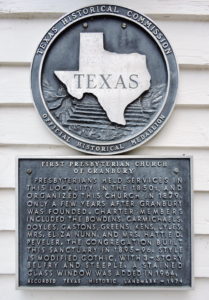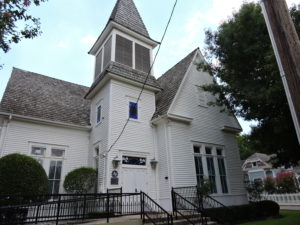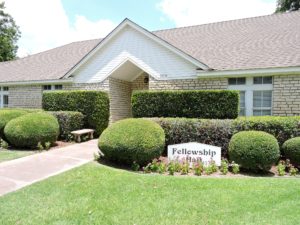
The history of the First Presbyterian Church of Granbury can be traced to the early settlers in Hood County in the mid-1800s. One of the earliest communities in Hood County was Walnut Creek, near Acton. Beginning in 1855, the residents near Acton, including some Presbyterians, shared a stone church building used by Baptist, Methodist, Presbyterian, and Reformed Christian congregations to conduct worship services. They continued to meet for worship in area churches during the following years. “Circuit Riders” from various denominations came on different Sundays to conduct worship services. Cumberland Presbyterian preachers, Ben D. and W. D. Austin, were among those circuit riding preachers.
In the years after the Civil War, the population expanded throughout the county and, in 1871, Granbury was founded as the County Seat. The Cumberland Presbyterian Church was officially organized with Reverend A.G. Martin as pastor in 1879. For the next seventeen years, the congregation held services in the Court House, the Baptist, and the Christian (Disciples) Church buildings.

The lot on which the church still stands was purchased for $300 in 1892. The Ladies Aid Society was formed and immediately began planning events to raise money for the new church building. In 1894 the adjoining property to the east was purchased and a parsonage was built for the first full-time pastor, C.C. McConnell. Construction of the sanctuary was begun in March of 1895 and was completed in April of 1896. The congregation decided to wait until all debts on the building were paid before holding a formal dedication. The mortgage was burned on Saturday, November 6, 1897 and the dedication service was conducted the following day.
For a while the Cumberland Presbyterian and “Old School” Presbyterians held services on alternate Sundays at the new church building and at a site on West Pearl Street. In 1906 the two congregations united and became known as the First Presbyterian Church, Granbury.
The next few years were fruitful as members continued to take an active role in the life of their growing community. From 1913 to 1920, there were adult and children’s Sunday School classes, a ten-piece orchestra that played every Sunday, and many youth activities. Though membership declined after World War I, during the Great Depression, and World War II, the spirit of the church never wavered. With the help of the Presbyterian Churches in the presbytery, pastors were supplied and help was given on maintenance of the church building. Many laymen and student pastors provided service.
In 1956, Jim Wright, mayor of Weatherford and an elder in the Weatherford Presbyterian Church, began preaching and conducting services on a regular basis. Activity in the church was revived. Wright would later be elected to the U.S. House of Representatives and serve as Speaker of the House. Speaker Wright would return to speak on the occasion of the church’s 100th anniversary and to preach at the dedication service when the church received a Texas Historical Marker in 1974.
Early in the 1960s the presbytery felt that there was no future for the First Presbyterian Church in Granbury and began plans to close the church. Legend has it that when the presbytery committee came to talk to the members about this decision, Elder Jake Morris, better known as Mr. Jake, the father of long-time members Jeanell Morris and Annadell Teems, had conveniently misplaced the keys. His words of wisdom were, “We are getting old and if God does not want a Presbyterian Church in Granbury, He will let it die with us.” The church never did close its doors and it certainly never died.
During this period, A. M. Pate, Jr., a Fort Worth businessman and philanthropist, and his family began to attend the church. The financial and moral support of the Pates and the tenacity of the small congregation began to bear fruit in the church.

In an ecumenical arrangement in 1972, the Roman Catholic congregation was invited to use the church building for their services and in 1973 the doors were also opened to the Lutherans. The Presbyterian elders felt this was a way for their small congregation to reflect the history of cooperation of the pioneers and to be “doing the Lord’s work.” This relationship fostered the establishment of a joint building fund for the restoration of the water-damaged steeple.
In 1974 the church was in a yoked-relationship with the Presbyterian Church in Stephenville and the Reverend John Brannon was called to serve both churches, to preach in both churches each Sunday, and to divide his pastoral time between the two congregations. This schedule required that the Lutherans find another building. Arrangements were made with the Catholic Church to stay for another year.
The opening of Lake Granbury and the many new housing developments and businesses during this period made the Granbury area one of the fastest growing in the state and the membership and activities of the church increased.
In 1982 the Reverend Elisha Paschal was called as part-time pastor. During his ten year ministry, membership not only increased, but a choir was organized, new Sunday School classes started, and a new organ, piano, and handbells were purchased. Many new fellowship activities were enjoyed and a financial commitment for church operations and missions was increased.
 A new fellowship hall, office, and classroom building was built across the street from the historic church building in 1992. In 1993, Dr. Charley Harnest was called as interim minister and ably served the congregation during the search for a pastor. Dr. Charles Somervill was called in 1994 as the first full-time pastor in more than 50 years. As Granbury continued its rapid growth, so did the membership of the church to over 300 members. This growth led to the need for two worship services each Sunday morning.
A new fellowship hall, office, and classroom building was built across the street from the historic church building in 1992. In 1993, Dr. Charley Harnest was called as interim minister and ably served the congregation during the search for a pastor. Dr. Charles Somervill was called in 1994 as the first full-time pastor in more than 50 years. As Granbury continued its rapid growth, so did the membership of the church to over 300 members. This growth led to the need for two worship services each Sunday morning.

The annex, or Memorial Hall, was built next to the historic church sanctuary in 2005. It includes a meeting room, session room, a parlor, a memorial garden, and columbarium. The columbarium is a final resting place for members, immediate family, and those holding a special affinity to the Church.
In 2013, Rev. Drew Travis, a fourth-generation Presbyterian minister, became our pastor. The congregation grew so much through his gentle spirit, tender care, and leadership that the church added a full time Associate Pastor and called Rev. Brenda Church on January 2020. This new position was a first for the church and for Drew. A two-pastor configuration was exciting and occasionally challenging as the Pastors and Congregation came to understand how the work would be done. Both pastors had their hands full preaching, teaching, tending to congregational and community needs, developing church leadership and the myriad array of administrative functions.
The life of the church took an unexpected turn with the onset of COVID. Among the chilling impacts of this disease was the loss of regular fellowship, isolation of membership, worship by the screen and the delayed Celebrations of Life of our beloved friends and family. The church emerged from this period a bit battle worn, but optimistic and faithful in what was, and what is to become. Our Pastors and Session were a powerful force for stability by keeping faith in God’s promise of grace and reconciliation.
We now find ourselves in another time of transition. Brenda accepted a new call effective August 12, 2022, to the Tres Rios Presbytery to begin her work in San Angelo, and Drew retired in February 2023. Thanks to solid Pastoral leadership, the Session is well outfitted with ingenuity and creativity to serve the needs of the congregation and community. Volunteerism to serve on committees and leadership roles is healthy. Emotional energy channels to the positive with little evidence of theological or political polarization. On May 1, 2023, Rev. Sherrolyn Weed became our Interim Pastor.
Our church is currently searching for a new Pastor. This will be a solo pastorate position. The Session, with the help of the new Pastor and congregational engagement, will determine future personnel configurations. We look forward to the future of the ministry in Granbury